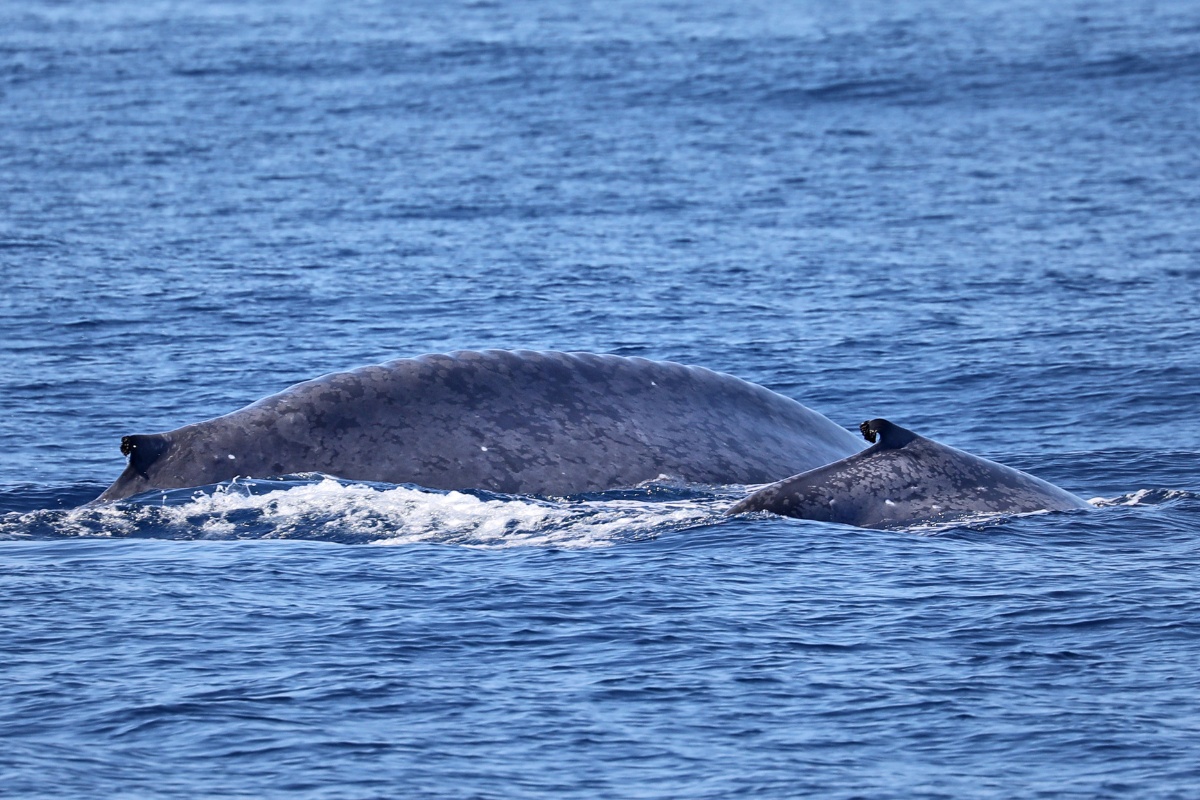From their gargantuan size to their voracious appetites, blue whale calves never cease to inspire wonder. Perhaps the most incredible aspect of the blue whale’s life cycle is the astonishing rate at which the calves put on weight in the early stages of life. Over just a few months, a blue whale calf can grow rapidly. It transforms from a sizable newborn into a true leviathan of the deep.

Table of Contents
Birthing Blue Whale Calves
When a mother blue whale gives birth, her newborn calf is already an impressive size. Weighing in at around 3 tons (that’s equal to 3 adult polar bears or 18 big football players!) and measuring up to 23 feet long, these babies are indeed giants in their own right. This remarkable size is the result of a lengthy gestation period. Blue whale pregnancies last approximately 12 months. During this time, the unborn calf steadily grows, fueled by the rich nutrients provided by its mother.
The blue whale calf wastes no time in capitalizing on its mother’s bountiful milk supply. The mother whale produces over 50 gallons of high-fat milk per day. This ensures her offspring is well-nourished and ready to pack on the pounds. The calf gains an astounding 200 to 250 pounds every day. This rapid growth occurs during the first 6 to 12 months of nursing. The calf’s weight increases by approximately 10 pounds every hour. It consumes only its mother’s milk.
Transitioning to Krill
After the initial nursing period, the blue whale calf is weaned off its mother’s milk and begins to transition to a diet of krill. These tiny crustaceans make up the primary food source for adult blue whales. They have evolved a unique feeding mechanism to filter and consume these abundant marine creatures efficiently. Blue whales use their baleen plates to swallow up to 50 gallons of water at once. They trap the krill inside their mouths and expel the excess water.
The blue whale’s prodigious appetite, from infancy through adulthood, is what allows it to reach its legendary size. A newborn calf may weigh 3 tons. An adult blue whale can tip the scales at a staggering 200 tons, which is more than 50 times its birth weight. That’s 1,200 big football players or 10 commercial jets. To put this into more perspective, the largest land mammal, the African elephant, weighs as much as a blue whale’s tongue.
Pleated Throats and Expandable Mouths
The blue whale has pleats or grooves on the underside of its mouth. These pleats enhance its feeding process. These pleats allow the whale’s mouth to open incredibly wide. This accommodates the enormous volume of water the animal takes in during a single gulp. The pleats stretch and expand, enabling the whale to engulf a volume of water greater than its own body size.
Breathing Adaptations
The blue whale’s size is not the only remarkable aspect of its physiology. These giants have also evolved specialized adaptations to support their ocean lifestyle. For example, their dual blowholes allow them to breathe while only the top of their head is above the water’s surface. Before diving back underwater, a flap covers the blowholes, sealing them shut to prevent water from entering.
Whale Calls and Vocalizations
Blue whales are known for their incredible vocalizations, which are some of the loudest sounds produced by any living creature. Their low-frequency calls can travel hundreds of miles through the open ocean. These calls have been recorded at up to 188 decibels, a volume comparable to a jet engine. These haunting, rumbling sounds serve as a means of communication and navigation for these massive marine mammals.
Habitat and Migration Patterns
The blue whale’s range is extensive, spanning all the world’s major oceans, from the poles to the tropics. These whales often hang out in open waters, but they may also be found near icebreaks, islands, and seamounts. Blue whales typically undertake long annual migrations. They move closer to the equator in the winter. In the summer months, they go to higher-latitude regions, such as the Arctic or Antarctica.
Conservation Challenges
Despite their sheer size and power, blue whales have faced significant challenges due to human activities. In the early 20th century, intensive whaling operations decimated the global blue whale population. The blue whale population was reduced from an estimated 350,000 individuals to just 1,000 by the mid-1920s. The species has been granted protected status. It remains classified as “Endangered” on the IUCN Red List. The ongoing threats and challenges include entanglement in fishing gear. Ship strikes are another threat. Climate change impacts their primary food source, krill.









